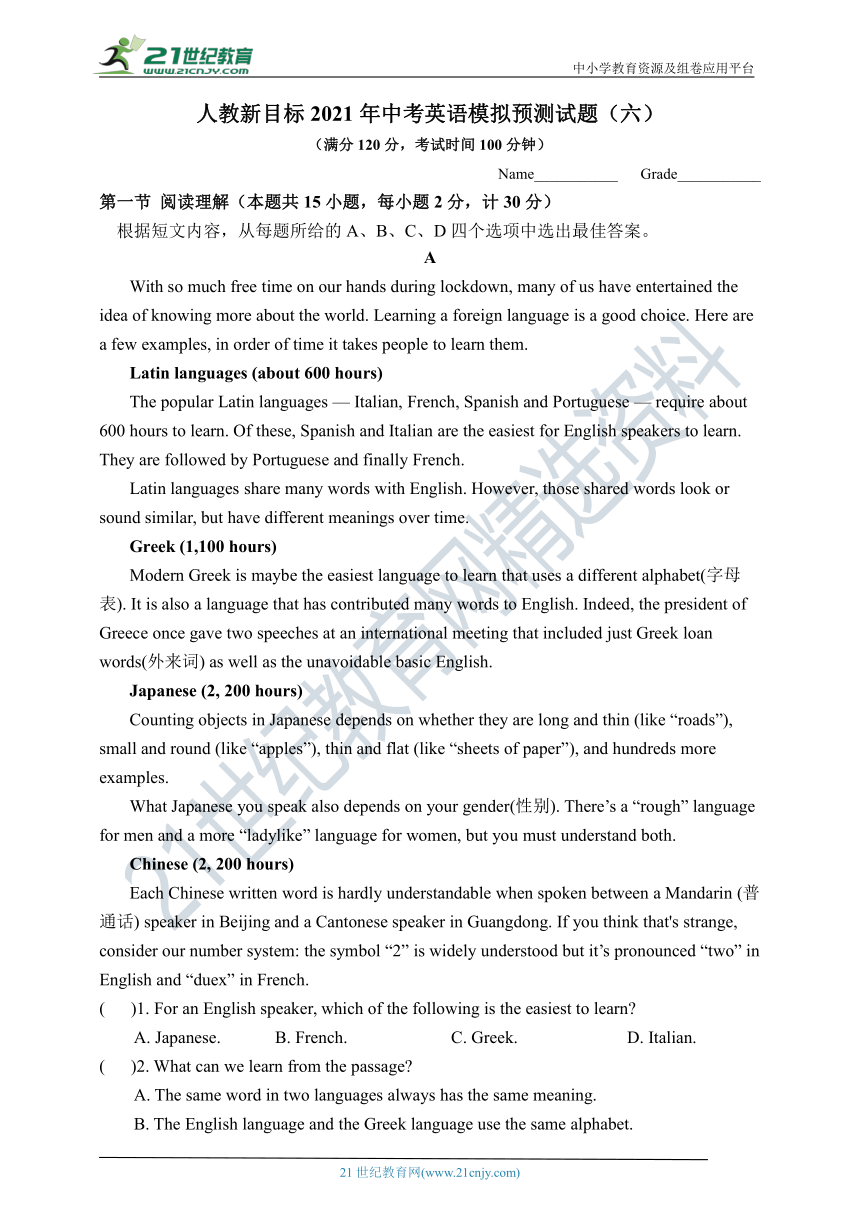
中小学教育资源及组卷应用平台 人教新目标2021年中考英语模拟预测试题(六) (满分120分,考试时间100分钟) Name_____ Grade_____ 第一节 阅读理解(本题共15小题,每小题2分,计30分) 根据短文内容,从每题所给的A、B、C、D四个选项中选出最佳答案。 A With so much free time on our hands during lockdown, many of us have entertained the idea of knowing more about the world. Learning a foreign language is a good choice. Here are a few examples, in order of time it takes people to learn them. Latin languages (about 600 hours) The popular Latin languages — Italian, French, Spanish and Portuguese — require about 600 hours to learn. Of these, Spanish and Italian are the easiest for English speakers to learn. They are followed by Portuguese and finally French. Latin languages share many words with English. However, those shared words look or sound similar, but have different meanings over time. Greek (1,100 hours) Modern Greek is maybe the easiest language to learn that uses a different alphabet(字母表). It is also a language that has contributed many words to English. Indeed, the president of Greece once gave two speeches at an international meeting that included just Greek loan words(外来词) as well as the unavoidable basic English. Japanese (2, 200 hours) Counting objects in Japanese depends on whether they are long and thin (like “roads”), small and round (like “apples”), thin and flat (like “sheets of paper”), and hundreds more examples. What Japanese you speak also depends on your gender(性别). There’s a “rough” language for men and a more “ladylike” language for women, but you must understand both. Chinese (2, 200 hours) Each Chinese written word is hardly understandable when spoken between a Mandarin (普通话) speaker in Beijing and a Cantonese speaker in Guangdong. If you think that's strange, consider our number system: the symbol “2” is widely understood but it’s pronounced “two” in English and “duex” in French. ( )1. For an English speaker, which of the following is the easiest to learn? A. Japanese. B. French. C. Greek. D. Italian. ( )2. What can we learn from the passage? A. The same word in two languages always has the same meaning. B. The English language and the Greek language use the same alphabet. C. Objects are counted differently in Japanese according to their shapes. D.A Mandarin speaker and a Cantonese speaker write Chinese differently. ( )3. The purpose of this passage is to tell English speakers_____. A. how to learn some foreign languages B. why they must learn a foreign language C. some information on the difficulty of foreign languages D. not to choose an Asian language to learn as it is too hard B One day, Tom was walking home when he suddenly noticed a young man sitting on the bridge railing (栏杆). He was going to jump into the river to kill himself. “Hey, young! What are you doing? Are you going to jump? ” Tom asked. “Yes, I am.” the young man answered. His voice had pain in it, but Tom could tell he didn’t reall ... ...
~~ 您好,已阅读到文档的结尾了 ~~